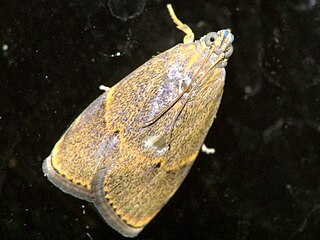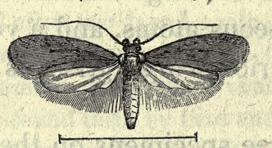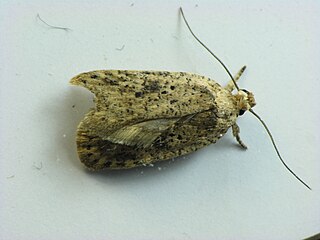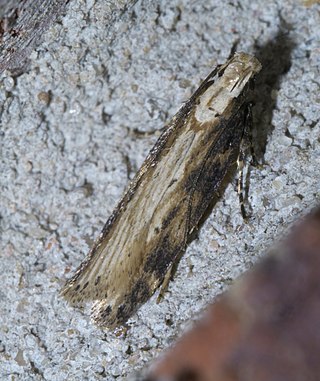
Imma mylias is a moth of the family Immidae. It is native to Sri Lanka, India, the Andaman Islands, the Philippines and Taiwan. It is an introduced species in Hawaii.

Sabatinca doroxena is a species of moth belonging to the family Micropterigidae. It is endemic to the North Island of New Zealand. This small moth has a colourful forewing pattern with stripes and dots evident. It has been hypothesised that the forewing pattern is intended to resemble a jumping spider in order to allow the adult moth to escape predation. Adults of this species are on the wing from the beginning of September until mid January. It prefers damp but sunny habitat in deep forest, at the forest edge or in open shrubland. Larvae feed on foliose liverwort species including on Heteroscyphus normalis. Adults of this species have been located at the blossoms of flowering Cordyline and Ranunculus species.

Cosmopterix gemmiferella is a moth of the family Cosmopterigidae. It is known from the United States and Canada (Ontario).

Agonopterix rotundella is a moth of the family Depressariidae and is found in most of Europe. It was first described from moths found in Surrey, England by the entomologist John Douglas in 1846.
Agonopterix antennariella is a moth in the family Depressariidae. It was described by John Frederick Gates Clarke in 1941. It is found in Washington, British Columbia and western Greenland.
Agonopterix psoraliella is a moth in the family Depressariidae. It was described by Walsingham in 1881. It is found in North America, where it has been recorded from California to Washington, Utah, South Dakota and Arizona.
Agonopterix amissella is a moth in the family Depressariidae. It was described by August Busck in 1908. It is found in North America, where it has been recorded from Florida.
Agonopterix gelidella is a moth in the family Depressariidae. It was described by August Busck in 1908. It is found in North America, where it has been recorded from Alberta, Maine, Manitoba and North Carolina.

Agonopterix senicionella is a moth in the family Depressariidae. It was described by August Busck in 1902. It is found in North America, where it has been recorded from Kentucky, Michigan, Ohio, Virginia and West Virginia.
Dichomeris condaliavorella is a moth in the family Gelechiidae. It was described by August Busck in 1900. It is found in North America, where it has been recorded from Florida.
Dichomeris vacciniella is a moth in the family Gelechiidae. It was described by August Busck in 1915. It is found in North America, where it has been recorded from Nova Scotia, southern Quebec and southern Ontario to Florida, Michigan, Missouri and Arkansas.
Helcystogramma melantherella is a moth in the family Gelechiidae. It was described by August Busck in 1900. It is found in North America, where it has been recorded from North Carolina south to Florida and west to Texas and Arkansas.
Chionodes ceanothiella is a moth in the family Gelechiidae. It is found in North America, where it has been recorded from Alberta and British Columbia to California and Utah.

Chionodes hibiscella is a moth in the family Gelechiidae. It is found in North America, where it has been recorded from Connecticut and Illinois to South Carolina, Louisiana, Mississippi and Texas.
Chionodes psiloptera is a moth in the family Gelechiidae first described by William Barnes and August Busck in 1920. It is found in North America, where it has been recorded from Quebec to British Columbia and then to Alaska, eastern Washington, Montana and New York.
Gnorimoschema terracottella is a moth in the family Gelechiidae. It was described by August Busck in 1900. It is found in North America, where it has been recorded from Florida and Alabama.
Anacampsis lagunculariella is a moth of the family Gelechiidae. It was described by August Busck in 1900. It is found in Panama, Cuba and the southern United States, where it has been recorded from Florida.
Nealyda pisoniae is a moth of the family Gelechiidae. It was described by August Busck in 1900. It is found in Cuba and the United States, where it has been recorded from Florida.
Cerconota carbonifer is a moth in the family Depressariidae. It was described by August Busck in 1914. It is found in Panama, Costa Rica and French Guiana.
Moca rugosella is a moth in the family Immidae. It was described by August Busck in 1914. It is found in Guyana.



